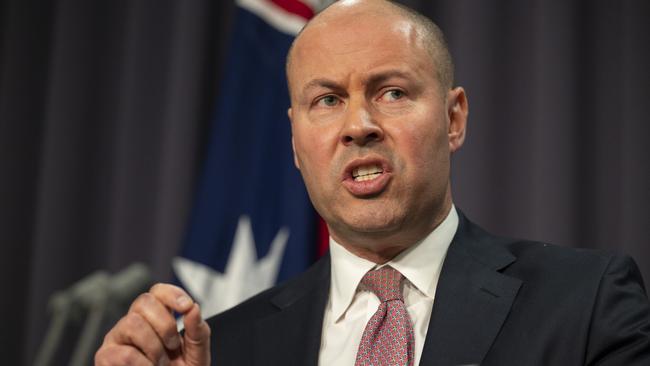
The fact the fifth Intergenerational Report released last month was a one-day wonder no doubt suits Josh Frydenberg. Not only was the document full of wild assumptions and debatable analysis, it was a story of doom and gloom.
Under every conceivable scenario reviewed there would be budget deficits and rising government debt for the next 40 years. Where once there was pride in Australia’s solid fiscal position, we are now heading towards the budgetary situation of many other countries where government spending invariably exceeds revenue and government debt just piles up. We may not be Greece but we are heading in that direction.
The most disappointing aspect of the report was its downplaying of the centrality of future productivity growth to determining economic prosperity and fiscal sustainability while promoting ramped-up immigration as some sort of panacea. This was summed up by the federal Treasurer when he asserted “a well-targeted, skills-focused migrant program can supplement our stock of working-age people, slow the transition to an older population and improve Australia’s economic and fiscal outcomes”. But is our migrant program well-targeted or particularly skills-focused?
Arguably, our pre-Covid program was a hotchpotch of badly designed components with the uncapped temporary parts providing the basis of a largely uncontrolled migrant intake. And digging under the surface, we find the skilled fraction of our migrant intake is actually very small.
There are only two immigration scenarios contained in the IGR – the high and the very high. (Why a low scenario was not modelled is anyone’s guess.) The first involves a fairly rapid return to the net overseas migration figures that were the norm pre-Covid, about 235,000 a year. That’s the high scenario.
The very high scenario is what Treasury calls “proportional migration”, whereby NOM as a proportion of the population is kept constant at 0.82 per cent. By 2060-61, net overseas migration will reach 327,000 a year. Under this scenario, the migrant intake will make up three-quarters of population growth; it has recently been about 60 per cent. Under normal circumstances, such a possibility would give any sensible analyst pause for thought.
How could such a disproportionate contribution of immigration to population growth be acceptable politically? But the Treasury boffins plough on, confirming their unqualified commitment to a big Australia based on very high rates of immigration.
But the proposition that more and more migrants will, in part, fix our fiscal problems is not really borne out by the figures provided in the IGR. Based on top-down modelling, the conclusion is reached that the underlying cash budget position could be 0.5 percentage points of GDP higher with proportional migration compared with the high migration scenario. This is because immigration temporarily delays the ageing of the population and workforce participation is higher.
It looks like a small return for a 40 per cent ramping up in net overseas arrivals. At least, Treasury concedes the composition of the migrant intake is critical to determining the economic and fiscal consequences. And it’s here Treasury’s analysis comes unstuck.
According to its figures, the only group of migrants that provides a net positive fiscal impact are skilled primary applicants. The other categories have negative effects, ranging from small to very large. (The key chart is 2.10.) Take skilled secondary applicants who accompany skilled primary applicants. We know they are less likely to participate in the labour force and have higher rates of unemployment than the skilled primary applicants. We also know their rates of participation are lower and their rates of unemployment are higher than Australian-born persons. When it comes to family and humanitarian migrants, the gaps are even wider, with these migrants having much lower participation and higher unemployment rates than Australian-born persons.
The magnitude of the fiscal drain of family and humanitarian migrants is alarming. The lifetime fiscal impact (which includes income tax, indirect taxes, education and healthcare, transfer payments and other expenditure) of family migrants is estimated at minus $137,000 a migrant, and for humanitarian entrants it’s minus $367,000 a migrant.
It’s obvious, on the basis of these figures, why successive Australian governments have felt the need to restrict the numbers of family migrants as well as keep the humanitarian intake to very low levels.
(Within the family stream, about 7000 slots are allocated to parent visas. According to the estimates of the Productivity Commission, each parent visa holder costs the Australian taxpayer between $335,000 and $410,000, in 2015-16 dollars.)
Aside from the obvious benefit of knowing the net fiscal gains/losses of different types of visa holders, the figures also show why Treasury is wrong in promoting more immigration as a fiscal solution. The arithmetic doesn’t work. There are too few skilled primary applicants to make up for the fiscal losses associated with migrants who come in under other visa categories.
Take the most recent (permanent) migration program planning levels of 160,000. The skill total is 79,600, but only 55 per cent of this number would be primary applicants. In other words, only 27 per cent of the permanent intake will make a positive fiscal impact, on the Treasury’s figures. The others will cause a fiscal drain and, in total, there will be an adverse fiscal loss because of the composition of the migrant intake. Incidentally, the permanent planning levels don’t include the humanitarian intake, which is set at 13,750 a year. Including these visa holders significantly adds to the adverse fiscal impact.
But permanent migration is only part of the story, with NOM dominated by temporary migrants. The largest group has been international students, with other groups including temporary workers, working holiday-makers, those on bridging and graduate visas and New Zealanders.
Now some temporary migrants pay tax, although recall that the temporary skilled migration income threshold is only $53,900 a year. But many temporary residents with work rights won’t pay any tax at all – think here many international students and working holiday-makers.
The bottom line is that it’s impossible to presume that immigration will provide a net boost to the budget because the number of skilled primary applicants is such a low proportion of the total migrant intake and many temporary migrants won’t pay any tax at all.
In any case, there’s something deeply unethical about attempting to lure the cream of the crop among workers from developing countries – they could use their services – to come here in order to pay taxes to cover the cost of government services which we receive but don’t want to pay for. Either cut back on these government services – something that should have been canvassed in the IGR – or get the locals to pay for them directly or pay more tax.
As former Productivity Commission chairman Gary Banks has said, “What is clear is that immigration policy is too important to be devised primarily on fiscal grounds or in relative seclusion.”



